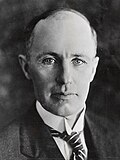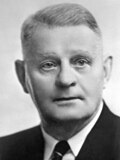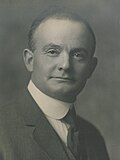1921 Canadian federal election
From Wikipedia, the free encyclopedia
The 1921 Canadian federal election was held on December 6, 1921, to elect members of the House of Commons of Canada of the 14th Parliament of Canada. The Union government that had governed Canada through the First World War was defeated, and replaced by a Liberal government under the young leader William Lyon Mackenzie King. A new third party, the Progressive Party, won the second most seats in the election.
This article needs additional citations for verification. (March 2010) |
| |||||||||||||||||||||||||||||||||||||||||||||||||||||||||||||||||||||||||||||||||||||||||||||||||||||
235 seats in the House of Commons 118 seats needed for a majority | |||||||||||||||||||||||||||||||||||||||||||||||||||||||||||||||||||||||||||||||||||||||||||||||||||||
|---|---|---|---|---|---|---|---|---|---|---|---|---|---|---|---|---|---|---|---|---|---|---|---|---|---|---|---|---|---|---|---|---|---|---|---|---|---|---|---|---|---|---|---|---|---|---|---|---|---|---|---|---|---|---|---|---|---|---|---|---|---|---|---|---|---|---|---|---|---|---|---|---|---|---|---|---|---|---|---|---|---|---|---|---|---|---|---|---|---|---|---|---|---|---|---|---|---|---|---|---|---|
| Turnout | 67.7%[1] (7.3pp) | ||||||||||||||||||||||||||||||||||||||||||||||||||||||||||||||||||||||||||||||||||||||||||||||||||||
| |||||||||||||||||||||||||||||||||||||||||||||||||||||||||||||||||||||||||||||||||||||||||||||||||||||
 The Canadian parliament after the 1921 election | |||||||||||||||||||||||||||||||||||||||||||||||||||||||||||||||||||||||||||||||||||||||||||||||||||||
| |||||||||||||||||||||||||||||||||||||||||||||||||||||||||||||||||||||||||||||||||||||||||||||||||||||
Since the 1911 election, the country had been governed by the Conservatives, first under the leadership of Prime Minister Robert Borden and then under Prime Minister Arthur Meighen. During the war, the Conservatives had united with the pro-conscription Liberal-Unionists and formed a Union government. A number of Members of Parliament (MPs), mostly Quebecers, stayed loyal to Sir Wilfrid Laurier, however, and they maintained their independence. When Laurier died, he was replaced as leader by the Ontarian Mackenzie King. After the 1919 federal budget, a number of western unionist MPs, who were former Liberals, left the Union government in protest against high tariffs on farm products imposed by the budget. Led by Thomas Alexander Crerar, the group became known as the Progressive Party. Also running were a number of Labour advocates, foremost amongst them J. S. Woodsworth of Winnipeg, who had organized their political movement after the Winnipeg general strike of 1919. Meighen had played a key role in violently suppressing the strikers and this earned him the animosity of organized labour.
Meighen attempted to make the "Unionist" party a permanent alliance of Tories and Liberals by renaming it the National Liberal and Conservative Party, but the name change failed, and most Unionist Liberals either returned to the Liberal fold or joined the new Progressive Party. Besides the labour strife and farm tariffs in the Prairie provinces, the Conscription Crisis of 1917 had a lasting effect on Tory fortunes by making the party virtually unelectable in Quebec.
The election was the first in which the majority of Canadian women were allowed to vote, thanks to reforms passed by the Conservatives. Five women also ran for office. Agnes Macphail of the Progressive Party was elected as the first woman MP in Canada.
Parliament was split three ways by this election. King's Liberals took 41 percent of the vote and won a majority government of just one seat. It won all of Quebec, much of the Maritime Provinces, and a good portion of Ontario.
The Progressive Party, including the United Farmers of Alberta (UFA), won the second largest number of seats, dominating the Prairies, and winning almost a third of the seats in Ontario. Liberal and Conservative candidates were shut out in Alberta, with 10 UFA and two Labour candidates taking the province's 12 federal seats. The party won only one seat east of Ontario, however. Despite winning the second most seats, it declined to form the official opposition. It would be the only Canadian federal election before 1993 in which a party other than the Liberals or the Conservatives/Progressive Conservatives won the second most seats.
The Unionists/Conservatives lost the most seats up to that time of any governing party at the federal level. They won fewer seats than the Progressives (despite having more popular votes) but were named as the official opposition anyway. The Conservatives won much of the Ontario seats and had some support in the Maritimes and British Columbia but won no seats in the Prairies or in Quebec.
Three Labour MPs were elected: Independent Labour candidate J. S. Woodsworth won a Winnipeg seat largely due to his role in the 1919 Winnipeg general strike, and Labour Party candidates William Irvine and Joseph Tweed Shaw were elected in Calgary.
Majority or minority?
Summarize
Perspective
King's party won a slim majority of seats in the election. But the government that King formed in the parliament after this election soon became a minority government due to resignations and subsequent byelection defeats.
But his government achieved a slim majority again. This was strengthened when it gained two seats from Progressives who crossed the floor.
The Liberal Party lost two by-elections to Conservative candidates, but its majority was not affected by these losses. From November 25, 1924, to the dissolution of parliament, it held a two-seat majority because of its victory in a by-election in a seat that had been held by the Conservatives.
The Progressive caucus was less united than the Liberals or Conservatives, due to the formation of the Ginger Group and the semi-autonomous United Farmers of Alberta group. The Farmer MPs had promised among other things that they would reject the traditional Parliamentary traditions such as that of bending to the will of the party leader and whip. Many Progressives argued that an MP should be able to vote against the party line so long as the vote was in accordance to his constituents' wishes. As a result, King always found enough Progressive MPs who backed him on crucial votes and he generally had a working majority, until after four years in power, in 1925 his government was brought down by an adverse vote due to a moment of confusion.
Electoral system
Most of the MPs were elected in single-winner First past the post; Ottawa and Halifax were two-seat ridings with each voter able to cast up to two votes as per Plurality block voting.[2]
National results
Summarize
Perspective

| Party | Party leader | # of candidates |
Seats | Popular vote | |||||
|---|---|---|---|---|---|---|---|---|---|
| 1917 | Elected | % Change | # | % | pp Change | ||||
| Liberal | W. L. Mackenzie King | 204 | 82 | 118 | +43.9% | 1,285,998 | 41.15% | +2.34 | |
| Conservative | Arthur Meighen | 204 | 153 | 49 | -68.0% | 935,651 | 29.95% | -26.98 | |
| Progressive | T. A. Crerar | 129 | * | 50 | * | 658,976 | 21.09% | * | |
| Labour | J. S. Woodsworth | 28 | - | 3 | 85,388 | 2.73% | +0.90 | ||
| Independent | 45 | - | 2 | 94,901 | 3.04% | +2.40 | |||
| United Farmers of Alberta | 10 | * | 10* | * | 22,251 | 0.71% | * | ||
| Unknown | 8 | - | - | - | 14,714 | 0.47% | +0.27 | ||
| Independent Conservative | 2 | * | 1 | * | 12,359 | 0.40% | * | ||
| United Farmers of Ontario | 1 | * | 1 | * | 3,919 | 0.13% | * | ||
| Independent Progressive | 1 | * | 1 | * | 3,309 | 0.115% | * | ||
| Socialist | 1 | * | - | * | 3,094 | 0.10% | * | ||
| Independent Liberal | 1 | - | - | - | 2,764 | 0.09% | -0.32 | ||
| United Farmers of British Columbia | 1 | - | - | - | 579 | - | |||
| Total | 635 | 235 | 235 | - | 3,123,903 | 100% | |||
| Sources: http://www.elections.ca -- History of Federal Ridings since 1867 | |||||||||
Note:
* not applicable - the party was not recognized in the previous election
* UFA candidates were sometimes referred to as Progressives,[3][4] just as sometimes "Progressive" candidates running outside Alberta were referred to as UFA.[5] All farmer/Progressive candidates running in Alberta were both UFA and Progressive, and sat as such in the House of Commons, at least until the UFA caucus became more independent. The vote shares of Progressive and UFA candidates shown above, if combined, are accurate for the two parties together as one.)
Vote and seat summaries
Results by province
| Party name | BC | AB | SK | MB | ON | QC | NB | NS | PE | YK | Total | ||
|---|---|---|---|---|---|---|---|---|---|---|---|---|---|
| Liberal | Seats: | 3 | - | 1 | 3 | 21 | 65 | 5 | 16 | 4 | - | 118 | |
| Popular vote (%): | 29.8 | 15.8 | 18.7 | 18.9 | 30.1 | 70.2 | 50.2 | 52.4 | 45.7 | 47.6 | 41.2 | ||
| Progressive | Seats: | 3 | 0 | 15 | 11 | 20 | - | 1 | - | - | 50 | ||
| Vote (%): | 11.7 | 0 | 61.7 | 41.9 | 25.6 | 3.1 | 8.7 | 10.2 | 12.3 | 19.7 | |||
| Conservative | Seats: | 7 | - | - | - | 36 | - | 5 | - | - | 1 | 49 | |
| Vote (%): | 47.9 | 20.3 | 16.3 | 24.4 | 38.8 | 18.5 | 39.4 | 32.3 | 37.2 | 51.1 | 30.0 | ||
| Labour | Seats: | - | 2 | - | 1 | - | - | - | - | 3 | |||
| Vote (%): | 6.8 | 11.1 | 0.8 | 5.7 | 2.3 | 0.7 | 3.5 | 4.8 | 2.7 | ||||
| Independent | Seats: | - | - | 2 | - | - | - | 2 | |||||
| Vote (%): | 3.5 | 7.4 | 1.9 | 6.6 | 1.7 | 1.3 | 3.0 | ||||||
| United Farmers of Alberta | Seats: | 10 | 10 | ||||||||||
| Vote (%): | 52.5 | 2.1 | |||||||||||
| Independent Conservative | Seats: | 1 | - | 1 | |||||||||
| Vote (%): | 0.9 | 0.3 | 0.4 | ||||||||||
| United Farmers of Ontario | Seats: | 1 | 1 | ||||||||||
| Vote (%): | 0.3 | 0.1 | |||||||||||
| Independent Progressive | Seats: | 1 | 1 | ||||||||||
| Vote (%): | 0.3 | 0.1 | |||||||||||
| Total seats | 13 | 12 | 16 | 15 | 82 | 65 | 11 | 16 | 4 | 1 | 235 | ||
| Parties that won no seats: | |||||||||||||
| Other | Vote (%): | 0.4 | 0.2 | 2.4 | 0.6 | 1.6 | 5.2 | 1.0 | |||||
| Socialist | Vote (%): | 1.8 | 0.1 | ||||||||||
| Independent Liberal | Vote (%): | 0.2 | 0.1 | ||||||||||
See also
Notes
- The United Farmers of Alberta, which at the time formed the government in that province, did not have a separate party leader at the federal level. At the time of this election, party leader Herbert Greenfield was the Premier of Alberta and the MLA for Peace River in the Legislative Assembly of Alberta.
- The United Farmers of Ontario, which at the time formed the government in that province, did not have a separate party leader at the federal level. At the time of this election, party leader Ernest C. Drury was the Premier of Ontario and the MLA for Halton in the Legislative Assembly of Ontario.
References
Further reading
Wikiwand - on
Seamless Wikipedia browsing. On steroids.








